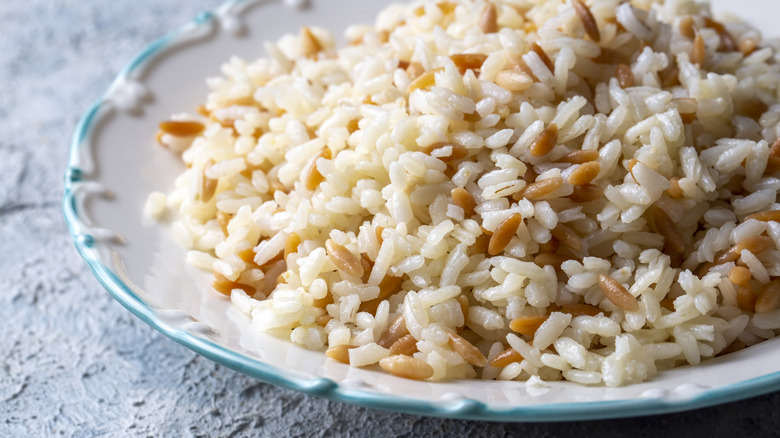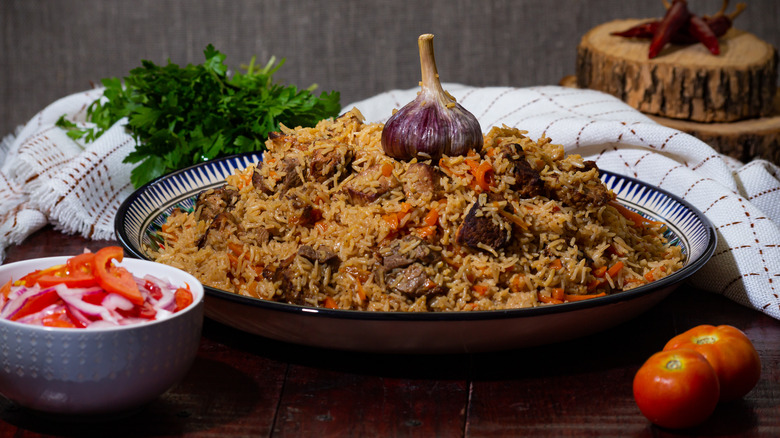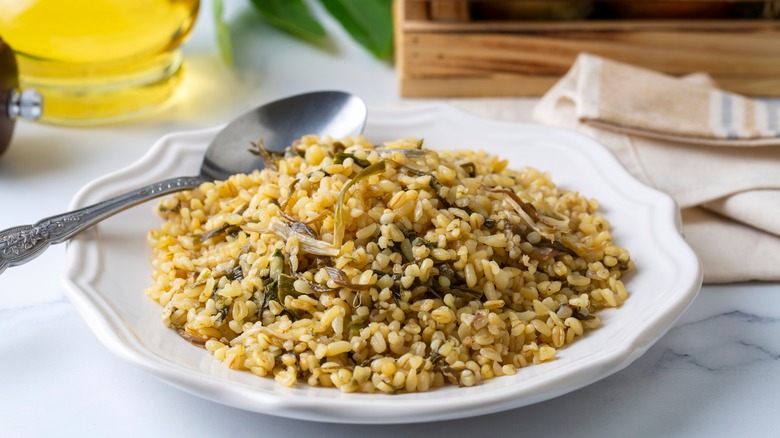What Is Pilaf And Why Do We Only Seem To Use It For Rice?
Rice pilaf is a very popular side dish here in the U.S., but despite this, the American perception of pilaf is a little limited. When you see rice pilaf on an American supermarket shelf or restaurant menu, what you're going to get is rice with some seasonings and maybe a few pieces of a small pasta shape, such as orzo or vermicelli. But in other parts of the world — Asia, the Middle East, Latin America — this rendition of pilaf would seem astonishingly basic. In most cases, pilaf is more than rice. It's a main course featuring wide varieties of meat, vegetables, nuts, and even fruits. But that doesn't diminish rice's central role in the dish.
If you're wondering why you only hear of pilaf in relation to rice, that's because pilaf almost always is rice. More accurately, it is a specific method of cooking rice. At the most fundamental level, pilaf refers to rice that has been cooked in broth and spices, both excellent ways to add flavor to plain rice. The other defining trait is that all the grains of rice must be separate, not sticky, and never, ever mushy. To achieve this, cooks wash the rice numerous times to remove all the exterior starch. Rinsing rice before cooking is one non-negotiable for making great pilaf. Aside from these factors, pilaf is very customizable, and throughout its history, many unique variations have arisen.
The history of rice pilaf
Pilaf was originally a Persian dish, dating back to at least the 10th century. That's when the first known recipe for pilaf was recorded by Ibn Sīnā (also known as Avicenna). Ibn Sīnā is considered one of the most prominent philosophers and scientists in Islamic history, and as if that weren't enough, he is widely credited today as the father of rice pilaf. The dish eventually spread beyond Persia, first to India when the country was under Muslim rule in the Middle Ages.
The origin of rice pilaf's name is difficult to trace because each language has a different word for it. In its native Iran, it is known as "polo". In Central Asia, it goes by names like palov and plov (which is the national dish of Uzbekistan). In India, it's "pulao" or "palao," and in the Caribbean, it's "pelau". Our version, "pilaf," most likely originated with the Turkish version, "pilav". "Pilaf" is unique to American English; in British English, it is called "pilau". Some theories point to the Sanskrit word "pulaka" as the original root, derived from a verb meaning, "to stand on end," which may reflect the way the rice grains are kept separate.
Just as each region has its own name for pilaf, all add their own unique ingredients. Mediterranean varieties use liberal olive oil, Indian versions often feature lamb and nuts, and the Persian take sometimes has a layer of crispy rice at the bottom called tahdig. It's not common, but there are even versions without rice.
There are a few pilaf variants that don't use rice
Pilaf almost always means a dish that is based on rice, but in rare situations, it can refer to a dish that is made with a different grain, but which is cooked in the style of rice pilaf. That is to say, cooking the grain in broth and spices and adding various proteins, fresh produce, fruits, and nuts to round it out. Lentils may be used, as well as orzo, which Americans will recognize as an ingredient in the boxed pilaf brand, Rice-A-Roni, which was inspired by an Armenian version of the dish (that version does, however, also contain rice).
One of the most popular non-rice-based variations is bulgur pilaf. Bulgur is whole wheat grains, cracked, parboiled, and dried so that they can be cooked just like grains of rice. It is a very common ingredient in Middle Eastern and Mediterranean cuisine, perhaps most famously in the form of tabbouleh, a type of chopped salad. Unsurprisingly, bulgur pilaf also comes from this region. It is a popular take on pilaf in Mediterranean and Middle Eastern countries, such as Turkey and Lebanon, typically prepared with the same ingredients as its rice-centric counterparts.


